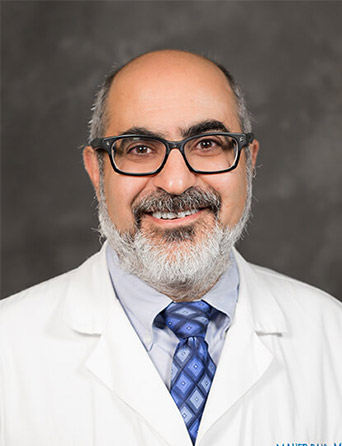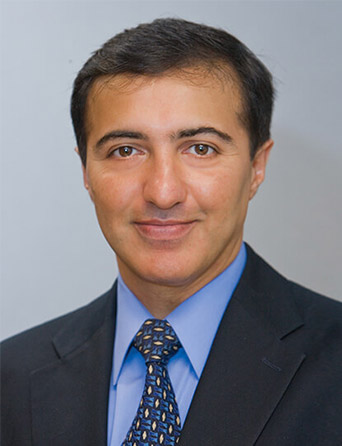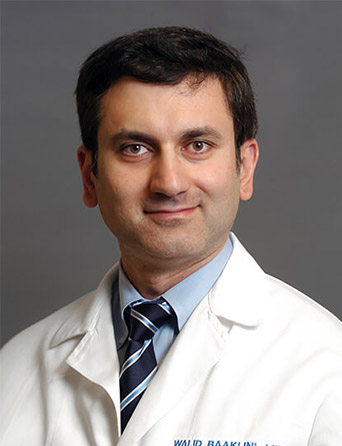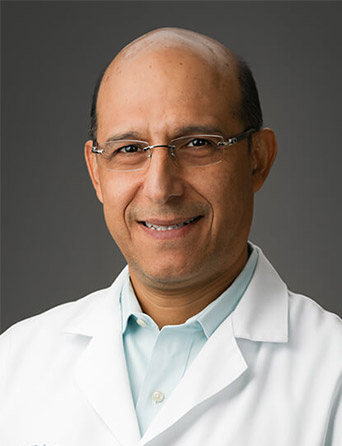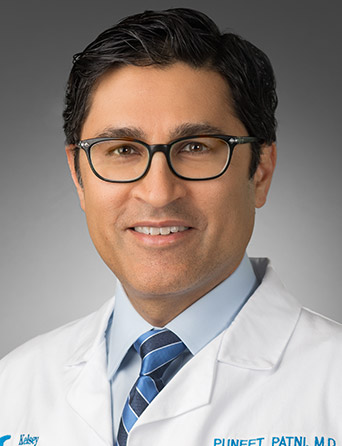Join Our eNewsletter!
Subscribe to our monthly newsletter to receive encouraging advice to help you lead a healthy lifestyle.

Sleep Apnea Can Be a Nightmare
If you snore, you might think keeping your partner awake is your biggest worry. But, if you have other symptoms in addition to snoring, such as waking up gasping for air, suffering from dry mouth, or being fatigued during the day despite getting a full night’s sleep, your snoring may be a sign of sleep apnea.
While loud snoring is the most noticeable and common symptom, it doesn’t necessarily mean someone has sleep apnea, a potentially serious disorder in which breathing stops and starts repeatedly while sleeping. These lapses in breathing cause poor quality sleep and lower the body’s supply of oxygen, which can lead to or aggravate serious health issues.
Sleep apnea is one of the most prevalent sleep disorders in the United States. Although it occurs in men more often than women, it can affect both sexes as well as children. While it’s likely that over 30 million adults in the U.S. suffer from obstructive sleep apnea, most of them probably don’t realize it. More than half of people over 65 are at high risk for obstructive sleep apnea, but only 8% of them are tested for it, according to a University of Michigan study.
Dangers of Sleep Apnea
Undiagnosed and untreated sleep apnea can cause serious mental and physical health issues. The daytime sleepiness and fatigue that result from poor sleep can leave you unable to concentrate and may cause you to fall asleep at work or even when driving. You might also become moody and depressed.
Physically, sleep apnea can cause high blood pressure due to sudden drops in blood oxygen levels, which can also increase your risk of recurrent heart attack, stroke, and abnormal heartbeat. If you already have heart disease, sleep apnea can lead to sudden death from an irregular heartbeat.
Sleep apnea is also linked to Type 2 diabetes because disturbed sleep can inhibit the body’s ability to process sugar. Those who already have Type 2 diabetes and develop sleep apnea may find their diabetes is exasperated.
People with sleep apnea are also more likely to have abnormal results on liver function tests, and their liver is more likely to show signs of scarring, which can indicate nonalcoholic fatty liver disease.
Sleep apnea can also cause issues with certain medications and general anesthesia. It can contribute to complications after major surgery for those prone to breathing problems, especially while they’re sedated and lying on their back. For this reason, anyone with diagnosed sleep apnea should make their care team aware of the condition prior to any surgical procedures.
Obstructive Sleep Apnea (OSA)
The most common form of sleep apnea, obstructive sleep apnea, occurs when muscles intermittently relax during sleep and the soft tissue in the back of the throat collapses and blocks the airway. While it’s normal for our muscles to relax during sleep, the throat usually remains open enough to let air pass through into the lungs.
When the airway is partially obstructed, snoring occurs. The soft tissues do collapse slightly, causing vibrations in the throat, but breathing isn’t interrupted.
In the case of OSA, the muscles relax so much that the tongue and uvula fall back completely, creating a full airway obstruction. Because air is unable to get to the lungs, breathing can be interrupted for up to one minute, until the brain becomes aware that breathing has stopped and jolts the airway clear. When this happens, it often makes the person wake up gasping for air. While breathing is paused, oxygen in the blood depletes and the heart rate slows down.

Signs and Symptoms of OSA
Since OSA occurs during sleep, you may not observe the signs on your own, or you may only be aware of the symptoms that are evident during waking hours. Nighttime symptoms might only be observed by your sleeping partner.
You may notice that you’re experiencing:
- Excessive daytime sleepiness
- Waking up gasping or choking
- Waking up with a dry mouth or sore throat
- Headaches in the morning that go away gradually
- Difficulty concentrating or focusing during the day
- Mood changes, such as depression or irritability
- High blood pressure
- Nighttime sweating
- Decreased libido

Your sleeping partner may notice that you’re experiencing:
- Loud snoring, especially when sleeping on your back
- Periods of time during sleep when you’re not breathing
- Mood changes, such as depression or irritability
- Gasping or choking during sleep
OSA Risk Factors
Your risk for developing obstructive sleep apnea increases if you have any conditions that can cause your upper airway to narrow, such as large tonsils or adenoids, a large neck circumference indicating excess fat around the airway, or an enlarged tongue.
More commonly, the following factors are found in people with OSA:
- Being overweight or obese. While anyone can have sleep apnea, having excess fat deposits around your upper airway is the most prevalent cause of OSA.
- Having a family history. You may be at higher risk if other family members suffer from obstructive sleep apnea.
- Being older. Although even children can have obstructive sleep apnea, episodes typically become increasingly worse or more frequent as you age. It’s most often diagnosed in adults over 50.
- Being a smoker. Smokers are three times more likely to have OSA because smoking can increase inflammation and fluid retention in your upper airway.
- Having certain chronic medical conditions. Several conditions are linked to OSA, including congestive heart failure, Type 2 diabetes, Parkinson’s disease, polycystic ovary syndrome (PCOS), hormonal disorders, and chronic lung conditions, such as asthma. Having high blood pressure can make sleep apnea symptoms worse, and vice versa.
- Having chronic nasal congestion. Any time you have difficulty breathing through your nose because of congestion, whether it’s because of allergies or an anatomical issue like a deviated septum, you’re at higher risk for episodes of OSA.
Central Sleep Apnea (CSA)
A much less common form of sleep apnea is central sleep apnea, which occurs when the brain fails to send the proper signals to the muscles that control breathing, resulting in periods of slowed or paused breathing typically lasting 10 to 40 seconds.
Signs and Symptoms of CSA
Most people with CSA don’t notice that their breathing is being disrupted during sleep. The pauses in breathing are most often only witnessed by a sleeping partner or caretaker.
Some signs those with CSA may notice about themselves include:
- Difficulty staying asleep
- Excessive daytime sleepiness
- Chest pain at night
- Difficulty concentrating
- Chronic fatigue
- Mood changes
- Morning headaches
- Lower tolerance for exercise
- Difficulty swallowing
- Voice changes
- Feeling weak or numb
They or their sleeping partner may also notice snoring, tossing and turning in bed, and abruptly waking up with shortness of breath. Snoring, however, isn’t as severe with CSA as it is with OSA.

CSA Risk Factors
Since CSA is a neurological issue, factors such as being overweight typically don’t increase a person’s risk. However, the factors that may contribute to CSA include:
- Being older. Central sleep apnea is more common in people who are middle-aged or older.
- Being male. Men suffer from CSA more than women.
- Having a heart disorder. If you have congestive heart failure, in which your heart muscles don’t pump enough blood for the body’s needs, or atrial fibrillation (irregular heartbeat), you are at increased risk of CSA.
- Having a stroke or brain tumor. If you have had a stroke or brain tumor, these conditions can impair your brain’s ability to send the correct signals to the muscles that control breathing.
- Using narcotic pain medications. Taking opioids can increase the risk of CSA because they can alter the brain’s ability to initiate and regulate breathing.
- Sleeping at a high altitude. Because sleep quality can be affected by low oxygen levels, it’s not uncommon for people who live in high altitude areas to experience CSA.
Interestingly, some people with obstructive sleep apnea develop central sleep apnea because they use a CPAP (continuous positive airway pressure) machine. Typically, the CSA subsides with continued use of the machine. In some cases, an alternative form of treatment needs to be used for OSA to avoid also developing CSA.
Sleep Apnea Diagnosis
If you suspect you may have either form of sleep apnea, your first step should be to see your primary care physician who will discuss your options with you. You may be referred to a sleep disorder center, such as the Kelsey-Seybold Sleep Center, for a home or in-clinic sleep study.
For a home sleep study, you’re sent home with equipment that measures heart rate, blood oxygen level, airflow, and breathing patterns. If your home sleep study results are abnormal, your doctor will likely recommend a full in-clinic sleep study.
During an in-clinic sleep study, you’ll spend the night at the Sleep Center, which is designed to mimic a home bedroom environment for comfort. Small electrodes will be attached to the skin of your head, near your eyes, and on your chest, legs, and chin. As you sleep, technicians and physicians will monitor your heart, lung, and brain activity, breathing patterns, arm and leg movements, and blood oxygen levels.
Treatment Options for Sleep Apnea
If you have a mild case of sleep apnea, you may find relief simply by sleeping on your side, losing some weight, or quitting smoking.
The most common medical treatment for moderate to severe obstructive sleep apnea is a CPAP machine, which involves placing a mask connected to a hose over your nose and mouth as you sleep. The machine then pushes pressurized air into your upper airway to prevent it from closing. However, your doctor may recommend a different type of airway pressure device, such as an auto-CPAP or a bilevel positive airway pressure (BPAP) device.
You may also find relief from a dental or oral appliance that brings your lower jaw up and forward, which helps keep the airway open.
If you’re not getting adequate rest, the first step to take toward better sleep is to talk to your primary care physician.

